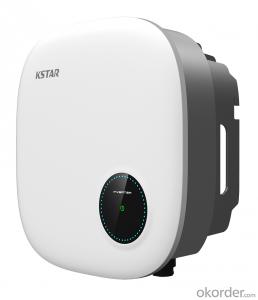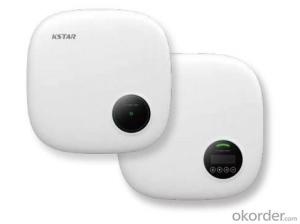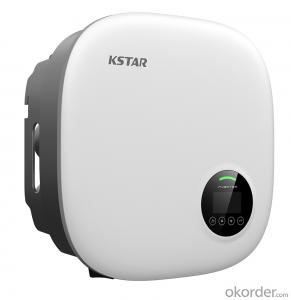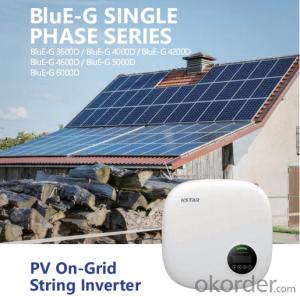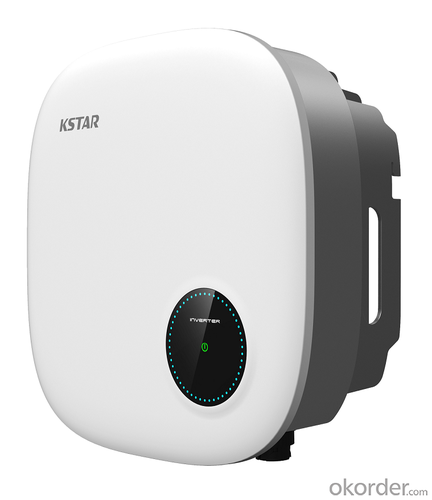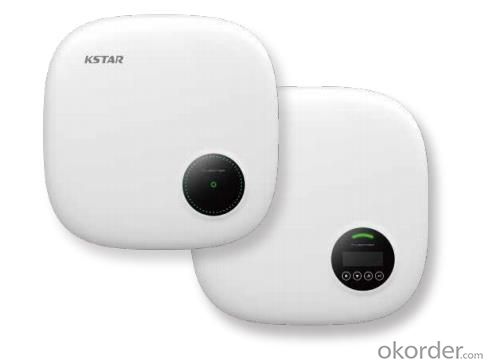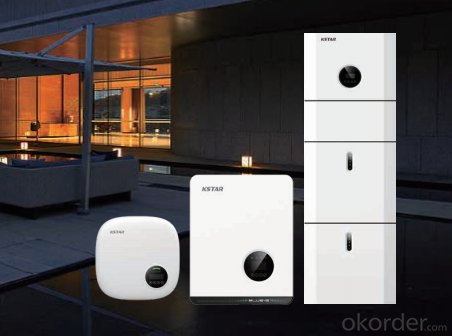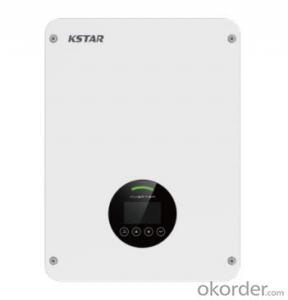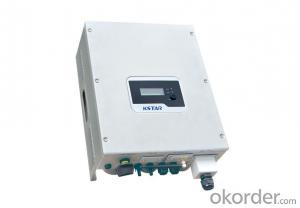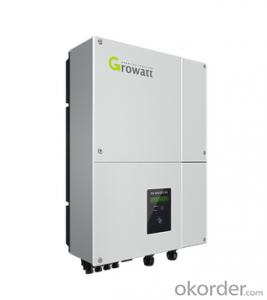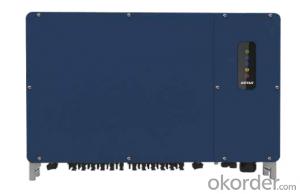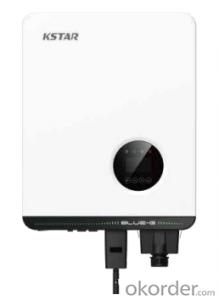Tata Solar Inverter String Grid-Tied PV Inverter Blue-G 3000D / 3600D / 4000D / 4200D / 4600D / 5000D / 6000D
- Loading Port:
- China main port
- Payment Terms:
- TT OR LC
- Min Order Qty:
- 50 pc
- Supply Capability:
- 15000 pc/month
OKorder Service Pledge
OKorder Financial Service
You Might Also Like
Specification
KSTAR BluE Power Your Green Life
Product Description:
★Max. PV voltage up to 600V DC/AC ratio up to 1.5
★Type II DC SPD/Type III AC SPD IP65 protection
★High efficiency up to 98.3% Smaller and lighter
★Compatible for big capacity PV panel WiFi / 4G Plug optional
One Stop Solution Compatible with any type of Demand
Our BluE series covers single phase 1 to 6kw, three phase 3-25kw and up to 20kwh Energy Storage System. This range is predominantly designed for modern house and small commericial energy demands.
One App to monitor your power flow for different systems;
One Call for pre-sales training & after-sales service;
Technical Specifications:
| MODEL | BluE-G 3000D | BluE-G 3600D | BluE-G 4000D | BluE-G 4200D | BluE-G 4600D | BluE-G 5000D | BluE-G 6000D |
| Input(DC) | |||||||
| Max. DC Voltage | 600Vdc | 600Vdc | 600Vdc | 600Vdc | 600Vdc | 600Vdc | 600Vdc |
| Nominal Voltage | 380Vdc | 380Vdc | 380Vdc | 380Vdc | 380Vdc | 380Vdc | 380Vdc |
| Start Voltage | 100V | 100V | 100V | 100V | 100V | 100V | 100V |
| MPPT Voltage Range | 80V-560V | 80V-560V | 80V-560V | 80V-560V | 80V-560V | 80V-560V | 80V-560V |
| Number of MPP Tracker | 2 | 2 | 2 | 2 | 2 | 2 | 2 |
| Strings Per MPP Tracker | 1 | 1 | 1 | 1 | 1 | 1 | 1 |
| Max. Input Current Per MPPT | 15A | 15A | 15A | 15A | 15A | 15A | 15A |
| Max. short-circuit Current Per MPPT | 18A | 18A | 18A | 18A | 18A | 18A | 18A |
| Output(AC) | |||||||
| Nominal AC Output Power | 3000W | 3600W | 4000W | 4200W | 4600W | 4600W | 4600W |
| Max. AC Apparent Power | 3000VA | 3960VA | 4400VA | 4620VA | 5060VA | 5500VA | 6000VA |
| Nominal AC Voltage | 230V L-N | 230V L-N | 230V L-N | 230V L-N | 230V L-N | 230V L-N | 230V L-N |
| AC Grid Frequency Range | 50Hz / 60Hz±5Hz | 50Hz / 60Hz±5Hz | 50Hz / 60Hz±5Hz | 50Hz / 60Hz±5Hz | 50Hz / 60Hz±5Hz | 50Hz / 60Hz±5Hz | 50Hz / 60Hz±5Hz |
| Max. Output Current | 14.4A | 17A | 19A | 20A | 22A | 24A | 26A |
| Power Factor (cosφ) | 0.8 leading to 0.8 lagging | ||||||
| THDi | <3%< td=""> | ||||||
| Efficiency | |||||||
| Max. Efficiency | 98.10% | 98.10% | 98.30% | 98.30% | 98.30% | 98.30% | 98.30% |
| Euro Efficiency | 97.70% | 97.70% | 97.90% | 97.90% | 97.90% | 97.90% | 97.90% |
| Protection devices | |||||||
| DC switch | Yes | Yes | Yes | Yes | Yes | Yes | Yes |
| Anti-islanding Protection | Yes | Yes | Yes | Yes | Yes | Yes | Yes |
| Output Over Current | Yes | Yes | Yes | Yes | Yes | Yes | Yes |
| DC Reverse Polarity Protection | Yes | Yes | Yes | Yes | Yes | Yes | Yes |
| String Fault Detection | Yes | Yes | Yes | Yes | Yes | Yes | Yes |
| Surge Protection | DC Type III;AC Type III | ||||||
| Insulation Detection | Yes | Yes | Yes | Yes | Yes | Yes | Yes |
| AC Short Circuit Protection | Yes | Yes | Yes | Yes | Yes | Yes | Yes |
| General Specifications | |||||||
| Dimensions W x H x D | 380*380*150mm | ||||||
| Weight | 10kg | 10kg | 11kg | 11kg | 11kg | 11kg | 11kg |
| Operating Temperature Range | –25℃~+60℃ | ||||||
| Cooling Type | Natural | ||||||
| Max. Operation Altitude | ≤4000m | ||||||
| Max. Operation Humidity | 0-100% | ||||||
| AC Output Terminal Type | Quick Connector | ||||||
| IP Class | IP65 | ||||||
| Topology | Transformer-less | ||||||
| Communication Interface | RS485/WIFI/4G | ||||||
| Display | LCD | ||||||
| Certification & Standard | EN/IEC62109-1/2;IEC/EN61000-6-2;IEC/EN61000-6-4;IEC61683;IEC60068;IEC60529;IEC62116; IEC61727;EN50549-1;AS 4777.2;NRS 097;VDE-AR-N-4105;VDE 0126-1-1;CEI0-21;G98;G99;C10/C11;TED749; UNE217001;UNE217002;NB/T32004-2018;GB/T19964-2012;INMETRO | ||||||
Q:How the output voltage of the PV inverter and the grid-connected voltage are determined
Inverter is the DC power (battery, battery) into alternating current (usually 220V, 50Hz sine wave). It consists of inverter bridge, control logic and filter circuit. Widely used in air conditioning, home theater, electric wheel, power tools, sewing machines, DVD, VCD, computer, TV, washing machine, range hood, refrigerator, video recorders, massage, fan, lighting and so on. In foreign countries
Q:Installation and maintenance of photovoltaic grid - connected inverter
only when the local power sector permission by the professional and technical personnel to complete all the electrical connection before the inverter can be connected.
Q:What is the difference between a PV grid-connected inverter and an off-grid inverter?
Off-grid inverter is equivalent to their own to establish an independent small power grid, mainly to control their own voltage, is a voltage source.
Q:After the PV inverter, how to achieve the same period before the network?
Solar panel simulator: with MPPT function, simulated morning, noon, afternoon, evening, rainy weather, solar panels produced under different conditions in different voltages.
Q:Is the PV inverter a current source or a voltage source?
According to the waveform modulation method can be divided into square wave inverter, stepped wave inverter, sine wave inverter and modular three-phase inverter.
Q:Photovoltaic grid-connected inverter without DC emc how will happen
Solar photovoltaic power generation technology is the use of solar cells, the photovoltaic effect of semiconductor materials, solar radiation can be directly converted into a new type of power generation system, solar energy is a radiant energy, solar power means --- to direct conversion of sunlight Into electricity,
Q:What is the difference between low voltage grid connection and medium voltage grid connection?
For photovoltaic power plants when the power system accidents or disturbances caused by photovoltaic power plant grid voltage drop, in a certain voltage drop range and time interval, the photovoltaic power plant can ensure that non-off-line continuous operation.
Q:Is the grid side of the grid and the inverter?
The grid load side of the grid is the grid. The inverter is an important part of the PV grid-connected system and can not be regarded as an external load. Photovoltaic power generation system is included in both grid and off-grid.
Q:PV grid-connected inverter and independent inverter in the control of what is the difference
The independent inverter in the output voltage phase amplitude of the frequency control is initially set good. Independent inverter, you should refer to off-grid inverter, do not need to consider the grid situation.
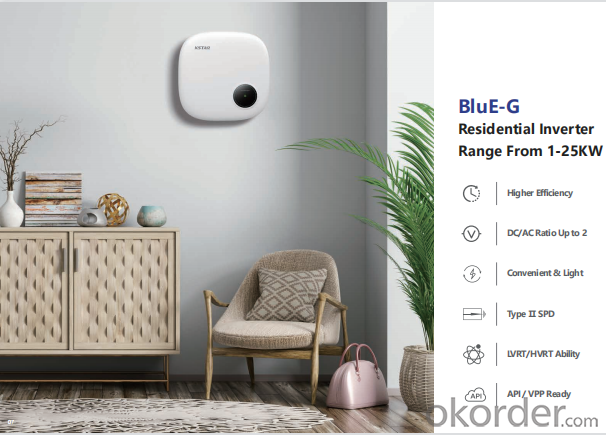
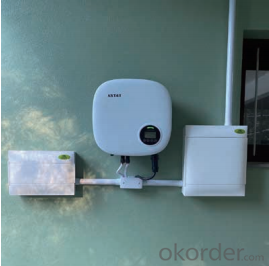
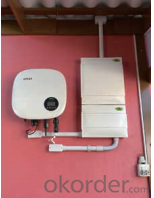
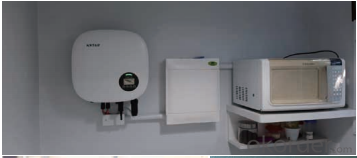

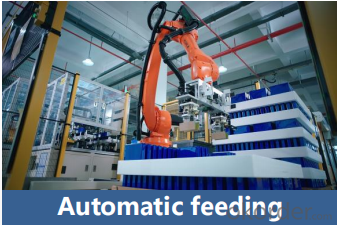
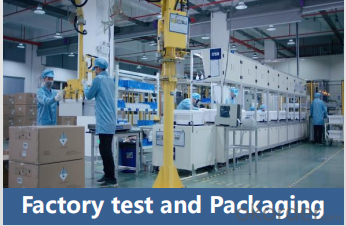
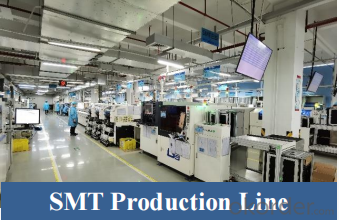
- Q: What is the role of a solar inverter in preventing system downtime?
- The role of a solar inverter in preventing system downtime is to convert the direct current (DC) produced by solar panels into alternating current (AC) that can be used to power electrical devices and to feed excess energy back into the grid. By maintaining a stable and reliable flow of electricity, solar inverters help prevent disruptions and downtime in the solar energy system, ensuring continuous operation and maximizing energy efficiency.
- Q: Can a solar inverter be used with a solar-powered swimming pool heater?
- Yes, a solar inverter can be used with a solar-powered swimming pool heater. A solar inverter converts the direct current (DC) produced by the solar panels into alternating current (AC) that is compatible with household appliances and equipment. Since a solar-powered swimming pool heater also relies on solar panels to generate electricity, the solar inverter can be used to convert the DC power from the panels into the AC power required to operate the heater.
- Q: Can a solar inverter be used in areas with high temperature fluctuations?
- Yes, a solar inverter can generally be used in areas with high temperature fluctuations. Solar inverters are designed to operate in a wide range of temperature conditions, typically between -20°C to 50°C (-4°F to 122°F), depending on the specific model. They are built with temperature protection mechanisms to ensure their functionality and durability even in extreme temperature variations. However, it is important to note that prolonged exposure to extreme temperatures at the upper or lower limits of their operating range can affect the performance and lifespan of the inverter. Therefore, proper installation and regular maintenance are crucial to ensure optimal performance in areas with high temperature fluctuations.
- Q: What is the maximum power capacity that a solar inverter can handle?
- The maximum power capacity that a solar inverter can handle depends on its specific model and specifications. In general, solar inverters can handle power capacities ranging from a few hundred watts to several megawatts, catering to various residential, commercial, and utility-scale solar installations.
- Q: Are there any ongoing maintenance requirements for a solar inverter?
- Yes, there are ongoing maintenance requirements for a solar inverter. Regular cleaning of the solar panels to remove dust and debris is necessary to maintain optimal performance. Additionally, inspections and tests of the inverter's components, such as cables and connections, should be conducted periodically to ensure everything is functioning properly. Monitoring the inverter's performance and addressing any issues promptly is also crucial for long-term maintenance.
- Q: Can a solar inverter be used in remote locations?
- Yes, a solar inverter can be used in remote locations. Solar inverters are designed to convert the DC power generated by solar panels into AC power that can be used to power electrical devices. They can be used in off-grid or remote locations where access to a traditional power grid is not available.
- Q: What is the maximum efficiency of a solar inverter?
- The maximum efficiency of a solar inverter refers to the highest level of energy conversion achieved by the inverter, typically expressed as a percentage. It represents the amount of solar energy that is successfully converted into usable electricity by the inverter. The maximum efficiency can vary depending on the specific model and technology used, but modern solar inverters can typically achieve efficiencies ranging from 95% to 98%.
- Q: Can a solar inverter be used with different types of power conditioning units?
- Yes, a solar inverter can be used with different types of power conditioning units. Solar inverters are designed to convert the DC power generated by solar panels into AC power that can be used by various electrical devices. They can be compatible with different types of power conditioning units, such as battery storage systems or grid-tied inverters, depending on the specific requirements and setup of the solar power system.
- Q: Can a solar inverter be used with a single solar panel?
- Yes, a solar inverter can be used with a single solar panel. The purpose of a solar inverter is to convert the direct current (DC) produced by the solar panel into alternating current (AC) that can be used to power electrical devices or be fed into the electrical grid. Even with a single solar panel, the inverter can still perform this function effectively.
- Q: How does a solar inverter handle voltage stability in the grid?
- A solar inverter handles voltage stability in the grid by continuously monitoring the voltage levels and adjusting its output accordingly. It maintains a stable voltage by regulating the power output from the solar panels and injecting or absorbing reactive power as needed. This helps to stabilize the grid voltage and prevent fluctuations that can disrupt the operation of electrical devices and appliances connected to the grid.
Send your message to us
Tata Solar Inverter String Grid-Tied PV Inverter Blue-G 3000D / 3600D / 4000D / 4200D / 4600D / 5000D / 6000D
- Loading Port:
- China main port
- Payment Terms:
- TT OR LC
- Min Order Qty:
- 50 pc
- Supply Capability:
- 15000 pc/month
OKorder Service Pledge
OKorder Financial Service
Similar products
Hot products
Hot Searches
Related keywords
